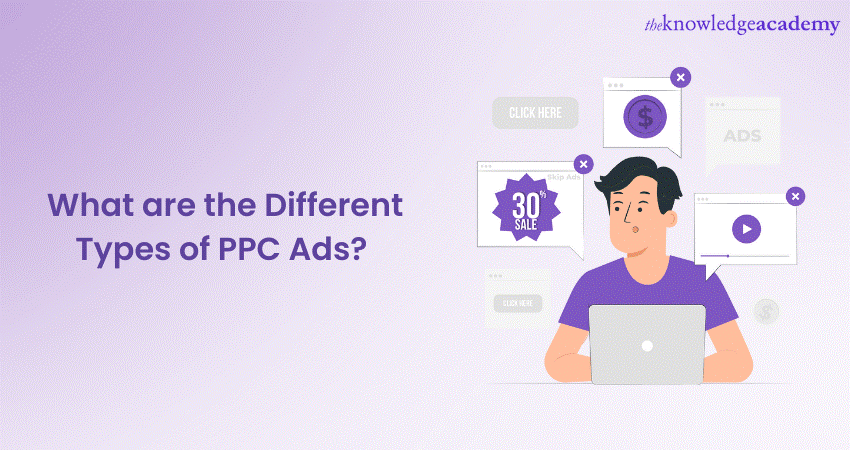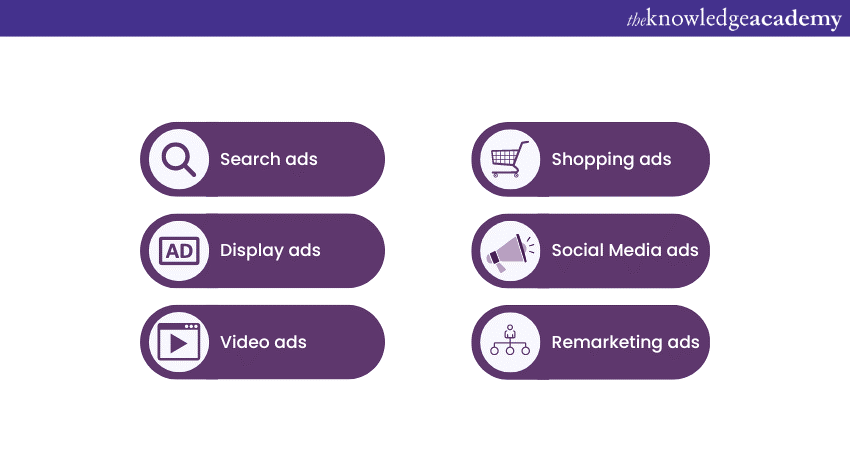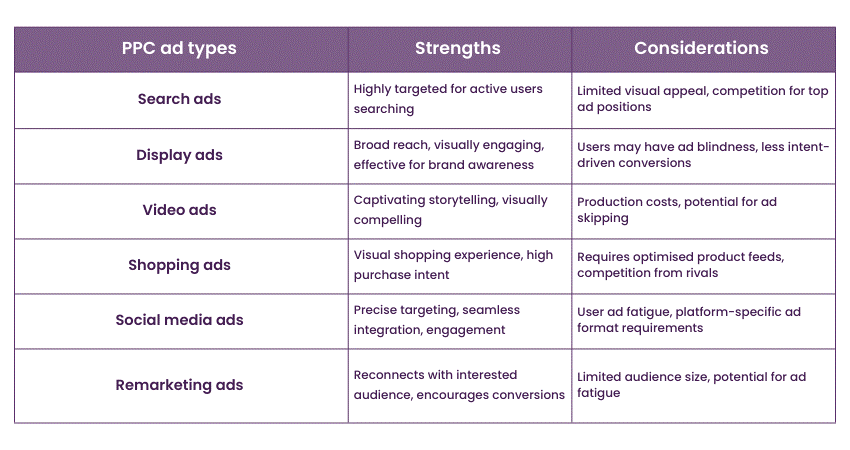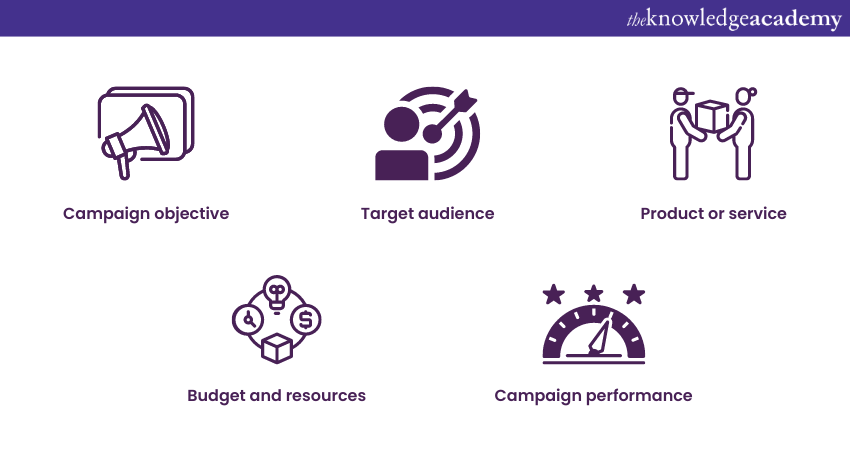We may not have the course you’re looking for. If you enquire or give us a call on 01344203999 and speak to our training experts, we may still be able to help with your training requirements.
We ensure quality, budget-alignment, and timely delivery by our expert instructors.

Pay-Per-Click (PPC) advertising has become an essential strategy for businesses to increase their online visibility in the fast-paced world of Digital Marketing. It's a successful advertising method to reach potential customers. However, with various Types of PPC ads available, it can be overwhelming for marketers to choose the right approach.
According to Statista, global spending on search advertising is projected to reach 220 billion GBP in 2023. earch ads are one of the most common Pay-Per-Click advertising methods, but there are many more types with unique characteristics, each used to achieve specific marketing goals.
Want to know what are these different types and how can they help your business mark your presence over digital platforms? Read this blog to learn about Different Types of PPC. Also, explore the key features of each of these types and their benefits.
Table of Contents
1) An overview of PPC advertising
2) Exploring the Types of PPC advertising
a) Search ads
b) Display ads
c) Video ads
d) Shopping ads
e) Social Media ads
f) Remarketing ads
3) Comparison of PPC Ad Types
4) Which PPC Ad is right for you?
5) Conclusion
An overview of PPC advertising
PPC allows businesses to display ads on various platforms, such as search engines (Google, Bing, Opera) and social media platforms, while paying only when users click on their ad. It is a highly targeted digital marketing strategy that enables multinational companies to reach their desired audience based on specific keywords, demographics, and user behavior. As businesses explore different options, many are now considering PPC alternatives to complement their marketing efforts.
Pay-Per-Click Ads appear alongside search engine results or within relevant websites and social media feeds. Leveraging PPC Tools allows businesses to efficiently manage campaigns, providing visibility to potential customers actively seeking products or services. This strategic approach helps increase brand awareness, drive quality website traffic, and achieve marketing goals.
Gain vital skills to boost your marketing skills with our Marketing Training!
Exploring the Types of PPC advertising
PPC advertising encompasses various types of ads, each with its unique characteristics and advantages. Understanding these different types can help businesses effectively tailor their advertising strategies to reach their desired demographic. Here are some key Types of PPC:

Search ads
Search ads are the most common and widely recognised type of PPC advertising. These ads appear alongside search engine results when users search for specific keywords or phrases. They typically display at the top or bottom of the search results page, marked as ads.
Search ads are highly targeted and relevant to users' search queries, making them an effective way to reach potential customers for their services or products. Advertisers frequently use keywords related to their business, displaying their ads when searched.
To create successful search ads, businesses need to conduct thorough keyword research, choose relevant and high-performing keywords, and craft compelling ad copy that entices users to click. Additionally, optimising the landing page for a seamless user experience is crucial for driving conversions.
Need to boost your conversions and revenue, refer to our blog on "How to improve PPC performance"
Display ads
Display ads are visually engaging and appear on websites within the Google Display Network or other ad networks. These ads include various formats, such as banner ads, interactive ads, and even video ads. Display ads aim to capture users' attention while they browse websites rather than appearing in search engine results.
The Google Display Network reaches a vast audience across millions of websites and apps. This makes display ads an excellent choice for increasing brand visibility, allowing a company to reach a broader audience. These advertisements can be highly targeted based on different factors like demographics, interests, and browsing behaviour. This allows online businesses to showcase their relevant products or services to users who are more likely to buy them.
To create effective display ads, businesses should focus on eye-catching visuals, clear messaging, and strong calls to action. It's essential to align the design and content of the ad with the target audience and the websites showcasing the ads.
Want to learn how to leverage PPC to mark your digital presence? Try our Pay Per Click (PPC) Masterclass!
Video ads
Video ads have become immensely popular in recent years, thanks to the rise of video-sharing platforms like TikTok and YouTube. These ads are displayed before, during, or after online video content, allowing businesses to engage viewers with captivating videos.
Video ads can be in various formats, such as skippable, non-skippable, or video discovery ads. Skippable ads allow viewers to skip the current advertisement after some time has passed, while non-skippable ads require viewers to watch the full duration. Video discovery ads appear alongside related video recommendations.
The key to effective video ads is creating engaging content that resonates with specific demographic, as they are more likely to purchase a product that way. Moreover, businesses should focus on storytelling, visual aesthetics, and delivering a clear message within a concise timeframe. Including a strong call to action at the end of the video can also encourage viewers to take further action.
Interested in learnong in-depth about SEO and PPC , refer to our blog on "SEO vs PPC"
Shopping ads
Shopping or product listing ads are specifically designed for e-commerce businesses. When users search for specific products or categories, these ads display product images, prices, and other relevant information directly on the search engine results page.
Shopping ads are highly visual and provide users with essential details about the product upfront, making them effective in driving targeted traffic to online stores. These ads can appear within dedicated shopping platforms or search engines like Google.
To set up shopping ads, businesses must create a product feed with detailed product information, such as title, description, price, and availability. Optimising the product feed and targeting specific product keywords are essential for ensuring the ads reach the right audience.
Fascinated with content marketing? Try our Content Marketing Masterclass course!
Social media ads
Social media platforms like Reddit, LinkedIn and X (previously known as Twitter) offer robust advertising options for businesses. Based on user data and profiles, social media ads allow businesses to target specific audiences based on their interests, behaviours and custom audiences. Social media ads can take various formats, including images, videos, carousels, and sponsored content. These ads seamlessly blend into users' social media feeds, appearing as native content.
The advantage of social media ads is the ability to target specific audience segments precisely. As a result, they ensure that the ads reach users interested in the products or services, thus increasing the likelihood of selling a product or service. The interactive nature of social media platforms also allows for increased engagement and social sharing.
To create effective social media ads, any organisation should understand the target audience's preferences, create visually appealing content, and utilise compelling copywriting. It's also essential to align the messaging and tone with the platform and the audience's expectations.
Remarketing ads
Remarketing ads, also known by the name retargeting ads, are an efficient way to reconnect with users who have used a website or shown interest in specific products or services. These ads are designed to reach users who have visited a website but left without making a purchase or conversion.
Remarketing ads follow users as they browse other websites or platforms, reminding them of products or services they showed interest in. This can help keep the brand top-of-mind and reward users for returning and completing the desired action.
Remarketing ads can be displayed across various platforms, including search engines, display networks, social media platforms, and email marketing. They can be highly personalised, showing specific products or offers relevant to the user's previous interactions.
To create effective remarketing ads, businesses should segment their audience based on their behaviour or interests and create tailored messaging that addresses their specific needs or concerns. Businesses should also provide incentives or promotions to encourage conversions.
Gain an in-depth knowledge of marketing with our Introduction to Marketing Training!
Comparison of PPC ad types
When it comes to PPC advertising, different types of ads offer unique benefits and serve specific purposes. Here is a comparison table of the key Types of PPC ads to understand their strengths and considerations. So, let’s have a quick look at each of these ads:

Learn about email marketing in detail with our Email Marketing course!
Which PPC ad is right for you?
Choosing the right type of PPC ad depends on various factors and your specific marketing goals. Consider the following points to determine which ad type is the most suitable for your business:

a) Campaign objective: Identify your primary campaign objective. Search ads may be the best choice if you aim to drive immediate conversions. Display ads or video ads can also be effective for brand awareness and reaching a wider audience.
b) Target audience: Understand your targeted demographic and their behaviour. Social media ads allow precise targeting based on demographics and interests. At the same time, remarketing ads can re-engage users who have shown previous interest. Consider which ad type aligns best with your audience's preferred platforms and behaviour.
c) Product or service: Different ad types work better for specific products or services. Shopping ads are ideal for e-commerce businesses, while video ads can effectively showcase products or demonstrate services. Consider which ad type complements your offerings and provides the best visual representation.
d) Budget and resources: Evaluate your budget and available ad creation and management resources. Video ads may require higher production costs, while search and remarketing ads are generally more cost-effective. Choose an ad type that aligns with your budget and resource capabilities.
e) Campaign performance: Analyse the performance of past campaigns or test different ad types on a smaller scale. Assess metrics such as click-through rates, conversions, and Return On Investment (ROI). Use this data to identify which ad type has performed well and aligns with your desired outcomes.

Conclusion
Understanding the various types of PPC ads is important for designing an effective Digital Marketing strategy. By utilising these ads, businesses can precisely target their audience and maximise their return on investment. As Pay-Per-Click advertising continues to evolve, staying up to date with the best practices and latest trends can give a competitive edge in the marketing arena.
Build expertise in mobile marketing with our Mobile Marketing Masterclass!
Upcoming Digital Marketing Resources Batches & Dates
Date
 Pay Per Click (PPC) Training
Pay Per Click (PPC) Training
Fri 11th Apr 2025
Fri 13th Jun 2025
Fri 15th Aug 2025
Fri 10th Oct 2025
Fri 12th Dec 2025






 Top Rated Course
Top Rated Course


 If you wish to make any changes to your course, please
If you wish to make any changes to your course, please


